Introduction
Birds bring joy, color, and life to any garden. By creating a bird-friendly garden, we can enjoy the cheerful songs and beautiful sights of various bird species throughout the year. This guide provides detailed and actionable steps to transform your backyard into a sanctuary for birds.
Table of Contents
Toggle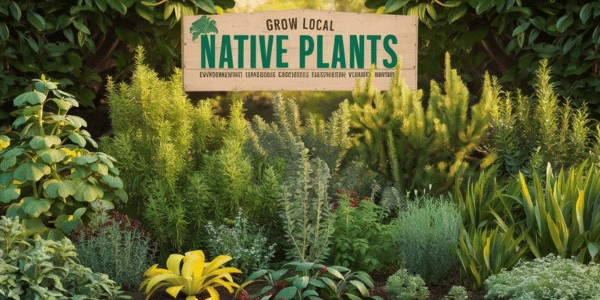
1. Grow Local Native Plants
Native plants are crucial for attracting local bird species. They provide food, shelter, and nesting sites tailored to the birds’ needs. Visit local parks to observe the native flora and the birds they attract. These plants are adapted to the soil, climate conditions, and pests that characterize the area, making them environmentally sustainable for your garden.
Benefits of Native Plants:
- Provide natural food sources like berries, seeds, and nectar.
- Offer suitable nesting sites and materials.
- Enhance biodiversity by supporting local insects, which in turn feed the birds.
Action Plan:
- Identify native plants that thrive in your area.
- Consult with local nurseries specializing in native flora.
- Incorporate a variety of plants to provide year-round resources.
You May Also Like: How to Keep Squirrels Out of Bird Feeders

2. Add Nest Boxes
Nest boxes do provide birds with a secure place for breeding. Therefore, research the types of birds that you desire to attract, as different species have specific nesting needs. The nest boxes should be safe and inaccessible to predators like cats and squirrels.
Key Considerations:
- Choose the right size and design for the target bird species.
- Place boxes at appropriate heights and locations.
- Regularly clean and maintain the nest boxes to prevent disease and parasites.
Action Plan:
- Install multiple nest boxes in diverse locations.
- Monitor and clean boxes after each breeding season.
- Provide natural materials for birds to build their nests.
You May Also Like: How to Use Apple Cider Vinegar to Clean Your Bird Bath

3. Provide a Bird Bath
A bird bath is needed for birds to drink and bathe. The bath should be shallow and placed in an open space devoid of predators. Adding rocks or pebbles can help small birds and insects access the water without drowning.
Benefits of Bird Baths:
- Offers a clean water source.
- It helps birds maintain their feathers.
- Attracts a variety of bird species.
Action Plan:
- Choose a bird bath with a gentle slope.
- Please place it in a shaded, visible spot.
- Change the water frequently and keep the bath clean.
You May Also Like: The Ultimate Bird Bath Guide: Perfect Bird Bath

4. Offer Food
Bird feeders are suitable for feeding birds because they come there regularly. To satisfy different species, use multiple feeders with different seeds available, plus clean them frequently to avoid spreading diseases caused by molds or other factors.
Types of Food:
- Seeds: Sunflower, millet, and nyjer.
- Fruits: Apples, berries, and grapes.
- Nectar: For hummingbirds and orioles.
Action Plan:
- Install various feeders and replenish them regularly.
- Plant fruit-bearing shrubs and trees.
- Avoid feeding processed foods or bread.
You May Also Like: What Color Attracts Birds To a Bird Bath?
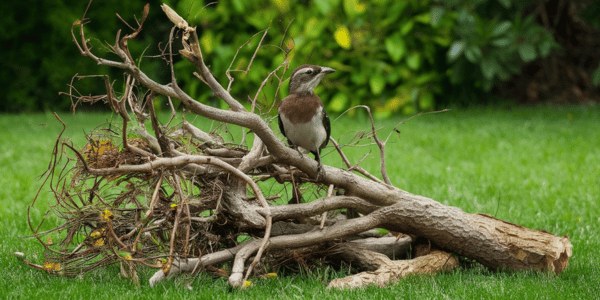
5. Leave Dead Branches and Debris
Dead branches and natural debris serve as insect habitats that feed birds. Untidy areas in your garden can create a natural environment that will attract various species of birds.
Benefits:
- Offers perching spots.
- Encourages insect populations for bird food.
- Provides natural nesting materials.
Action Plan:
- Leave dead branches on trees or in piles.
- Create brush piles in quiet garden corners.
- Minimize garden cleanup to maintain natural habitats.
You May Also Like: Blue Grosbeak vs Indigo Bunting: Birdwatcher’s Guide
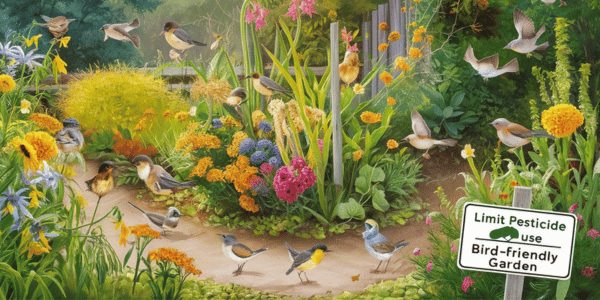
6. Limit Pesticide Use
Use a few pesticides to save the bird’s source of food from being poisoned selectively. Sometimes, when necessary, select organic alternatives that support wildlife.
Tips:
- Hand-pull weeds and use natural compost.
- Encourage beneficial insects to control pests.
- Use organic sprays and fertilizers.
Action Plan:
- Adopt organic gardening practices.
- Promote a healthy, balanced ecosystem.
- Educate yourself on natural pest control methods.
You May Also Like: How to Keep Squirrels Out of Bird Feeders: Effective Strategies
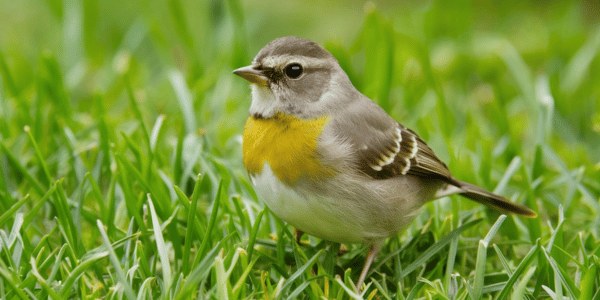
7. Let Grass Grow
Allowing portions of your lawn to grow taller provides cover and homes for insects and smaller animals, which in turn encourages the presence of birds.
Benefits:
- Creates a natural habitat.
- Encourages insect populations.
- Reduces lawn maintenance.
Action Plan:
- Designate areas for tall grass.
- Incorporate wildflowers for additional food sources.
- Rotate mowing schedules to maintain diverse habitats.
You May Also Like: Can Birds See At Night?
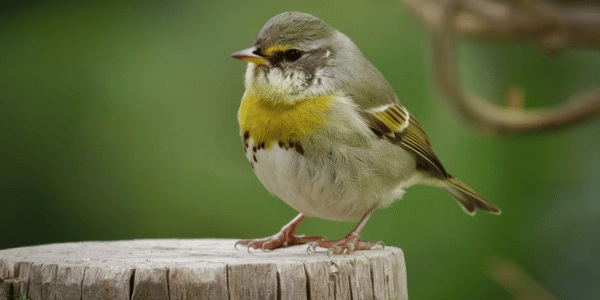
8. Protect Birds from Predators
Predators, especially domestic cats, pose significant threats to birds. Implement measures to create a safe environment for your feathered visitors.
Strategies:
- Keep cats indoors or supervise them outside.
- Install predator guards on nest boxes and feeders.
- Use deterrents to keep predators away.
Action Plan:
- Educate pet owners on the impact of free-roaming cats.
- Employ safe and humane predator control methods.
- Design your garden with bird safety in mind.
You May Also Like: Should You Feed Birds in Summer?

9. Ensure Year-Round Blooming
Plant flowers and fruiting vines that provide resources throughout the year. This continuous food supply helps sustain birds during different seasons.
Seasonal Planting:
- Spring: Wildflowers and nectar-rich blooms.
- Summer: Fruit-bearing shrubs and vines.
- Fall: Seed-producing plants.
- Winter: Evergreen shrubs and berry-producing trees.
Action Plan:
- Plan a garden calendar for year-round blooms.
- Mix annuals and perennials for variety.
- Research plants that thrive in each season.
You May Also Like: The Top 5 Yellow-Breasted Birds in Texas
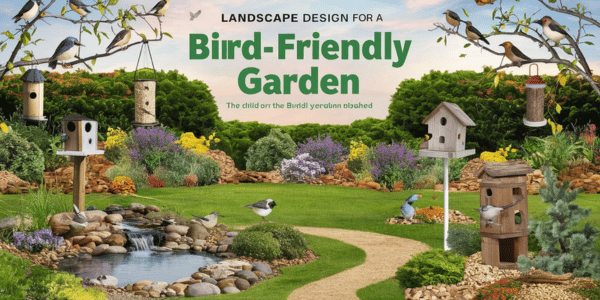
10. Major Landscaping for Birds
Transform your garden into a bird paradise by stratifying it into different layers. This mimics natural habitats and provides diverse resources for various bird species.
Layering:
- Canopy: Tall trees for nesting and shelter.
- Understory: Shrubs and small trees for food and cover.
- Ground cover: Grasses, vines, and low plants for insects and nesting material.
Action Plan:
- Design a multi-layered garden layout.
- Use native plants for each layer.
- Incorporate water features and natural elements.
Conclusion: Creating a Bird-Friendly Garden
Creating a garden that is friendly to birds requires careful planning coupled with sustainable practices. These actions include providing food, water, shelter, and safety, which will attract many kinds of bird families. Apply these tips to convert your yard into a welcoming abode for all types of birds, irrespective of the season.
FAQ: Creating a Bird-Friendly Garden
1. What are the essential elements to attract birds to my garden?
Native plants should be provided together with food sources like insects or fruiting trees such as berries and nuts, among others, which may also serve as feeding spots towards this goal, hence sustaining one’s locality’s avian population.
2. Why should I use native plants in my garden?
When planted locally, they cater to the preferences of indigenous bird species while supporting biodiversity within your region.
3. How can I create safe nesting sites for birds?
Install bird boxes high in trees or on posts in quiet areas. Ensure they are secure and protected from predators.
4. What types of food should I provide for birds?
Multiple feeders can offer various seeds, including those for hummingbirds or other nectar-feeding varieties. Fruits can also be found inside them after being snacked upon by certain berry-growing shrubs and trees.
5. How can I make my garden a safe place for birds?
Reduce the use of pesticides, keep cats indoors, and provide dense shrubs and trees for natural cover. Additional shelter and food can be available in tall grasses and debris.
6. Why is water essential for a bird-friendly garden?
Birds require water for drinking and bathing. Ensure that the bird baths are shallow and made of rocks or pebbles to prevent drowning and that they are located in open areas where safety should not be an issue.
7. How can I ensure birds have resources year-round?
Different species should be planted so that other types of flowers will blossom and bear fruits at various times within a year. This provides continuous food and shelter throughout all seasons.







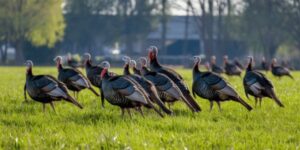

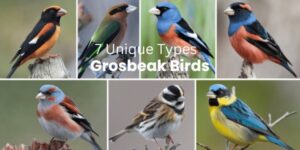


2 thoughts on “Amazing Ways to Create Your Bird-Friendly Garden Today!”